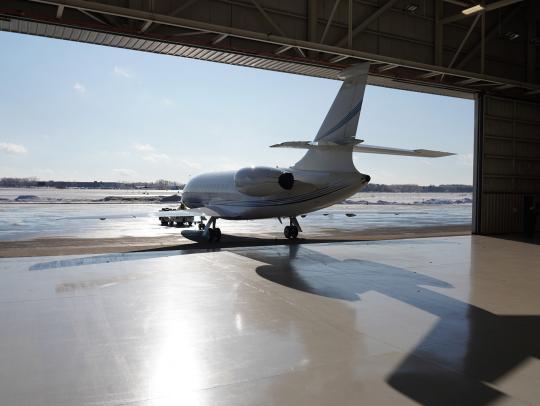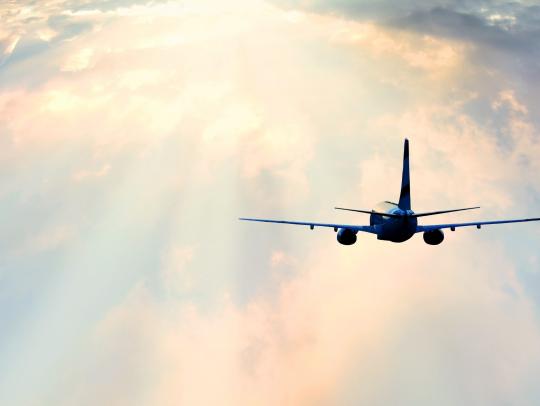Enabling Extraordinary In-flight Experiences


and Market Intelligence
For aviation companies, delivering exceptional customer experiences is essential to maintaining a competitive edge. As the passenger demand for in-flight connectivity (IFC) grows, airlines are increasingly invested in adopting the cloud and high-performance connectivity services to meet customer expectations.
We asked Max Heinen, VP of Strategy and Market Intelligence at SES, to expand on the key factors contributing to the evolution of the aviation industry.
What are some of the biggest trends in the aviation industry?
In-flight connectivity (IFC) is one of the most dynamic markets in the world today, with consumer demand for connectivity driving rapid evolution. Airline passengers expect to be able to access the applications they use at home or at work—even at 30,000 feet above ground. To address this growing demand for connectivity, airline companies are forming key partnerships with connectivity providers, and in the process, laying the foundation for transformative innovation in IFC over the next few years.
Another major trend is the rise of the ‘connected aircraft’ concept. The adoption of cloud-based smart aircraft technologies will play a huge role in the digital transformation journey for airline companies.
How is the Covid-19 pandemic impacting airlines?
In the commercial aviation industry, the decrease in demand for air transport due to the pandemic has had significant economic impact. Yet, with global vaccination efforts in effect, Euroconsult predicts that the demand for air travel will return to pre-pandemic levels by 2022. The business aviation industry, in contrast, has continued to expand and evolve through the course of the pandemic, with more passengers choosing business travel due to its safety aspect.
Going forward, airlines will adopt technology such as cabin monitoring, gate-to-gate connectivity to enable digital self-service processes and digital identity management. In addition, e-health solutions like the digital health passport will be crucial to ensuring enhanced safety for air travellers. These applications, together with IFC and smart aircraft technologies, will drive the need for high-performance connectivity services.
Can you dive a little deeper into how IFC is evolving?
 IFC is quickly becoming a necessary component in driving passenger loyalty for airlines worldwide. Offering free IFC has shown to positively impact net promoter scores (NPS)—a key metric that helps airlines gauge customer loyalty. According to a Panasonic Avionics report, approximately 76% of global travellers select an airline based on the connectivity services offered onboard. While the number of travellers demanding connectivity is growing rapidly, the need for high-quality services is also increasing. Both leisure and business travellers expect to receive connectivity that supports bandwidth-intensive applications—whether for social media and streaming, or work-related video conferencing and cloud-based productivity tools.
IFC is quickly becoming a necessary component in driving passenger loyalty for airlines worldwide. Offering free IFC has shown to positively impact net promoter scores (NPS)—a key metric that helps airlines gauge customer loyalty. According to a Panasonic Avionics report, approximately 76% of global travellers select an airline based on the connectivity services offered onboard. While the number of travellers demanding connectivity is growing rapidly, the need for high-quality services is also increasing. Both leisure and business travellers expect to receive connectivity that supports bandwidth-intensive applications—whether for social media and streaming, or work-related video conferencing and cloud-based productivity tools.
Air travellers expect to have access to free connectivity services to support basic messaging and social media applications, while paying for IFC packages to support their more bandwidth-heavy applications. To ensure customer satisfaction, a few major airlines are offering a free IFC model and simplifying passenger IFC packages—opting for application-based billing rather than the volume-based billing model offered traditionally. Our estimate is that this will boost take rates from approximately 17% today to more than 60% in the future.
Globally, North American airlines are leading the growth of IFC, and influencing trends in Europe, the Middle East, Africa, and Asia. According to Euroconsult and Valour Consultancy, over 100 commercial airlines offer IFC to their passengers as of 2021, an estimated 14% of all commercial airlines. There are around 9,000 connected aircraft worldwide, and around 26,000 aircraft are yet to be connected—a huge opportunity for all the players in the industry.
How is the cloud transforming the aviation industry?
Cloud applications play a critical role in enabling digital transformation. The ‘connected aircraft’ relies on real-time operational analytics—including flight tracking, weather and black-box monitoring, video surveillance, engine health monitoring, communications with headquarters, and cargo tracking and monitoring. This new generation of ‘smart’ aircraft relies on interconnected sensors that are all connected to the cloud. The cloud is not only crucial to enabling the ‘smart’ aircraft, but is also a key element in enhancing the passenger experience, facilitating services such as in-flight entertainment (IFE) content and onboard purchasing.
Airlines are increasingly cognisant of the cloud’s potential to drive value and their digital strategy —improving operational efficiency aboard the aircraft can save costs, and enhancing customer experiences can keep them ahead in a fiercely competitive market.
Looking ahead, it’s critical that airlines have access to cloud-optimised connectivity with the throughput, security, and reliability they need to support their digital transformation.
How is SES supporting airline companies?
 Each airline has a different strategy for IFC, with packages curated specifically to meet its passenger requirements. For example, within commercial aviation alone, there could be different solutions catering to different passenger types—a premium model suited to business passengers and a freemium model for leisure passengers. At SES, we ensure that we can meet an airline’s strategy with an appropriate business model and connectivity solution.
Each airline has a different strategy for IFC, with packages curated specifically to meet its passenger requirements. For example, within commercial aviation alone, there could be different solutions catering to different passenger types—a premium model suited to business passengers and a freemium model for leisure passengers. At SES, we ensure that we can meet an airline’s strategy with an appropriate business model and connectivity solution.
Working closely with the world’s leading IFC service providers, we’ve ensured that our satellites can meet the capacity requirements in the aviation industry. High-throughput connectivity and global coverage via our geostationary high-throughput satellites (GEO HTS), together with one-hop connectivity to the cloud, ensures that we can support the dynamic in-flight connectivity market—both now and in the future.
Related Content
| Listen to the LuxStream Part 1 episode | |
| Listen to the LuxStream Part 2 episode | |
| Find out more about our services |

